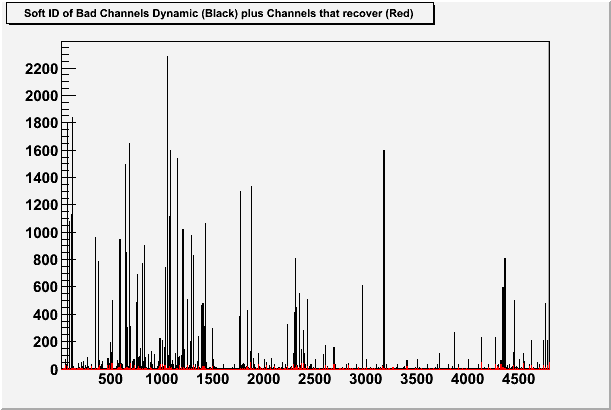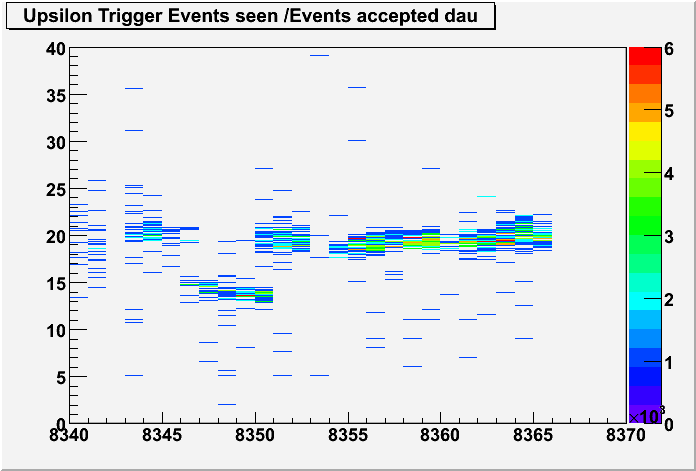
The online upsilon trigger kept a record of the dynamic masking per run, this is a list of the dynamic masking over run 07 and 08
List of dynamic masking run 7 and 8
This plot shows the dynamic bad towers masked and the towers that recovered is shown in red

The amount of events fed to the Upsilon trigger is recorded in the logbook as "Seen" and the amount the trigger keeps as "Accepted". The ratio of "Seen vs. Accepted" should be constant. For the AuAu runs this ratio was about 2 and for the dAu runs it was about 20
|
AuAu seen/accepted
|
dAu seen/accepted
|
For AuAu this seem stable but for dAu notice the peak near 15. To investigate this I plotted the ratio vs. run number

It seems there is a region of runs, 8346k to 8351k, where the upsilon trigger acceptance changed. The barrel plots during this period show noise in an area of phi=1 and eta 0-1.
Example of good run: Notice the BEMC is uniform |
||
|
|
||
In range 8346k to 8351k note noise at phi=1 eta 0-1 range: |
||
|
|
|
|
I have intergrated the trigger code into the analysis. The trigger has some variations that I was interested in looking at to see the effect on the spectra
Question 2: We do not use the point maker but trace the track to the centre of the tower, instead of the face of the tower. This was a method recommended by Murad, how did it effect the trigger simulation
Question 3: We have a list of the dynamic masked towers from the run in the logbook, what would happen if these were integrated into the simulation
The trigger simulation code with all the dynamic masking switched off
The trigger simulation code with the dynamic masking switched on
The trigger simulation code with all the towers masked dynamically found from the trigger logbook record
The "cluster case" where the track traced to one of the trigger id clusters and no the seed tower
The first case has no dynamic masking in the simulator. Apart from these test, it will also be useful in the future to run this on the embedded data and compare to the dynamic masking
The second case simulates the trigger as it was during the online data taking. Here a test will be made to see if the difference in masking found by running over uDsts vs. the real online masking will have any effect
The forth case was to try to emulate the trigger as close as possible to "online dynamic masking". Here the online dynamic masked towers were recreated from the logbook and applied "per run". This is not exact as the event number recorded by the trigger will not match the event number recorded in the uDst, so we can only gather all the towers masked in a run and apply them togther instead of switching them on (or off) exaclty as they were during the run. This assumption is however a harsher cut than the dynamic masked towers used during a real data taking and is good to get a rough estimate of the effect
The final case is related to matching a TPC track to towers. We can track to the center of a "Seed" tower or the 3x3 array around the seed tower.
No dynamic masking
|
Offline dynamic masking
|
Masked towers were very rare when separate uDst, which are segments of a full run, were analysed individually. The Upsilon trigger will reset for each new file and the masks are rare. If the uDst files were grouped into runs and analysed together more towers would be masked but this will have no relation to the real online conditions and is best avoided. The integral between 8GeV to 11GeV is 186 counts
No dynamic masking
|
Online dynamic masking
|
In this case we have applied the online dynamic masking from the upsilon trigger logbook "per run", i.e we applied all masks found in a logbook for that run and compare that to the case with the dynamic masking switched off in the Upsilon trigger. Tracks were then matched with the pairs found by the trigger. The effect is small. For the range 8GeV to 11GeV the integral is 186 counts with no mask and 184 with the online mask, about a 1% change. This method of applying all masks found for a run is a harsher selection than the real dynamic masking would be and we can conclude that the effect of dynamic masking is very small at less than 1%
The trigger returns the seed and and array of towers around the seed, during tracking we can match to either the seed tower or the seed plus array to compensate for errors on the edge of a BEMC tower. However, Murad had another method to overcome this, by extrapolating the track to the centre of a tower, near the SMD, which is the method I use in all my analysis

Track traced to centre of tower and matching L2 seed tower
|
Track traced to centre of tower and matching L2 array around seed
|
In this case adding the array gave a few more counts, for the integral between 8GeV to 11GeV for the seed tower gave 184 counts and the seed plus cluster gave 188 countsas the tracking will match more towers, about 2% more. In this case the spectra look similar but it will be interesting to see how this case acts with the AuAu data with denser tracks
It is rare for a dynamic "Bad masked" tower to go "Good"
The "Bad masked towers" are pretty much the same set of hot towers
Between runs 8346k to 8351k the dAu Upsilon trigger efficiency changed and this seems to be due to a hot patch in the BEMC
From comparing the case with no dynamic masking and the "online dynamic masked" towers being applied to the uDsts over a run, which is an approximation to the real situation and harsher than the real online, we can conclude that the effect of the dynamic masking is very small, less than 1%, and will have a negligible effect on the results. This gives us confidence that the dynamic masking will not distort the results in unusual ways and is a safe selection to apply
With the data submitted in small segments of a run, the dynamic masking code in the trigger has little to no effect on the offline analysis
Taking the track to the "cluster plus seed" or "seed only" tower has a small effect in dAu sample when the track is traced to the SMD. This may be different for AuAu with the increased track density however